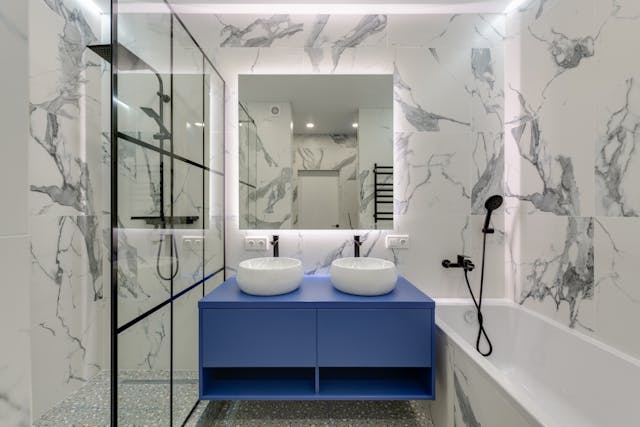Selecting the right bathroom tiles is crucial when designing a space that is both functional and aesthetically pleasing. Whether you are renovating your existing bathroom or building a new one, the right tiles can elevate the design, enhance durability, and ensure easy maintenance. In this comprehensive guide, we’ll explore everything you need to know about how to pick bathroom tile like a pro, from understanding different types of tiles to choosing the right colors and materials.
If you are considering a full home makeover, incorporating modular kitchen interior design in Bangalore or living area interior design in Bangalore, this guide will help you approach bathroom tile selection with the same level of professionalism and precision.
1. Understanding the Importance of Bathroom Tiles
Tiles are not just about looks; they serve essential functions in the bathroom. They protect surfaces from water damage, enhance cleanliness, and, when chosen correctly, can complement the rest of your home’s interior design. Just like a well-designed modular kitchen interior design in Bangalore or a thoughtfully curated living area interior design in Bangalore, the tiles in your bathroom should align with the overall theme of your home while meeting the functional requirements of the space.
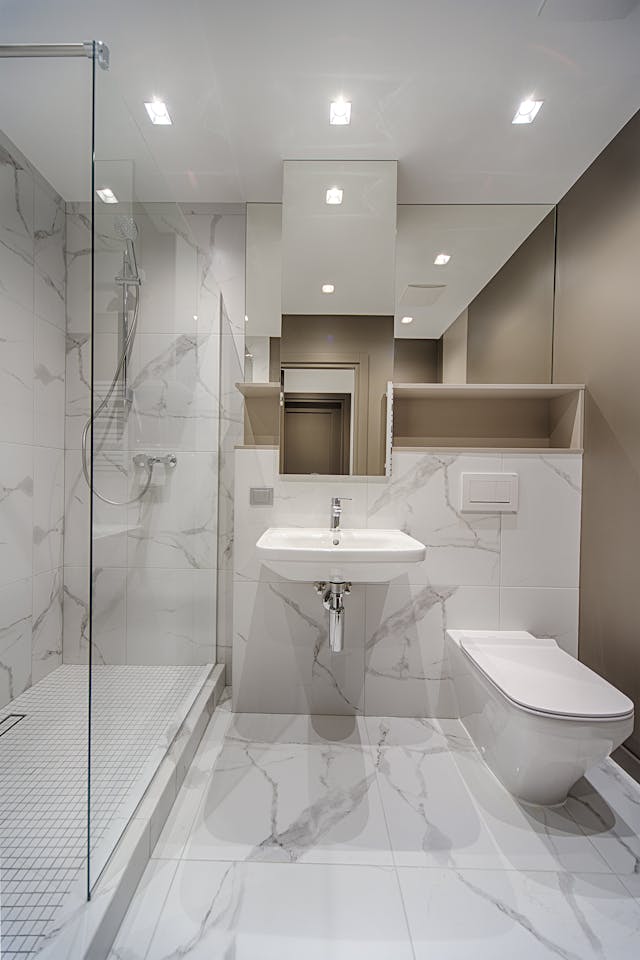
Why Tiles Matter in the Bathroom
- Water Resistance: Bathrooms are high-moisture environments, and tiles act as the first line of defense against water damage. Choosing the right material ensures the longevity of your surfaces.
- Durability: Bathroom tiles must withstand heavy foot traffic, spills, and the constant use of water.
- Aesthetic Appeal: Bathroom tiles can significantly enhance the look of the space, making it feel luxurious or relaxing depending on your style.
Common Tile Areas in a Bathroom
Tiles are often used in the following key areas:
- Walls: Around showers, bathtubs, and sinks.
- Floors: Especially where high foot traffic and moisture are present.
- Backsplashes: Decorative tiles used around the sink and mirror area.
2. Types of Bathroom Tiles
Choosing the right tile material is the first step to achieving both the look and functionality you want. Just like in living area interior design in Bangalore, where you choose the right furnishings and decor for functionality and aesthetics, selecting the correct tiles ensures the bathroom meets your needs while looking beautiful.
Ceramic and Porcelain Tiles
- Ceramic Tiles: Known for being budget-friendly and versatile, ceramic tiles are available in numerous designs and finishes. They’re durable, easy to clean, and resistant to moisture, making them a popular choice for walls and floors.
- Porcelain Tiles: A higher-density type of ceramic tile, porcelain is more durable and water-resistant, making it an excellent choice for high-moisture areas like shower walls and bathroom floors.
Natural Stone Tiles
- Marble: Known for its luxurious and timeless look, marble adds elegance to any bathroom. It’s ideal for creating focal points, but it requires regular maintenance and sealing.
- Granite: Durable and resistant to stains and scratches, granite tiles are perfect for bathroom floors and walls. However, they also require sealing to maintain their beauty.
- Travertine: A softer stone compared to granite, travertine has a rustic appeal but needs extra care to prevent scratches and stains.
Glass Tiles
- Glass tiles offer a sleek, modern look and work well in smaller bathrooms or as accent pieces. They reflect light, brightening the space, but can show water spots and require regular cleaning.
Vinyl Tiles
- Vinyl Tiles: These are affordable, water-resistant, and available in many styles. They are a great option for bathroom floors, especially in high-traffic areas, and come in peel-and-stick formats for easy installation.
Mosaic Tiles
- Mosaic tiles come in various shapes, sizes, and colors. They are used for creating patterns, accent walls, and borders. The versatility and design possibilities of mosaic tiles make them perfect for adding a unique touch to your bathroom.
3. Key Considerations When Picking Bathroom Tiles
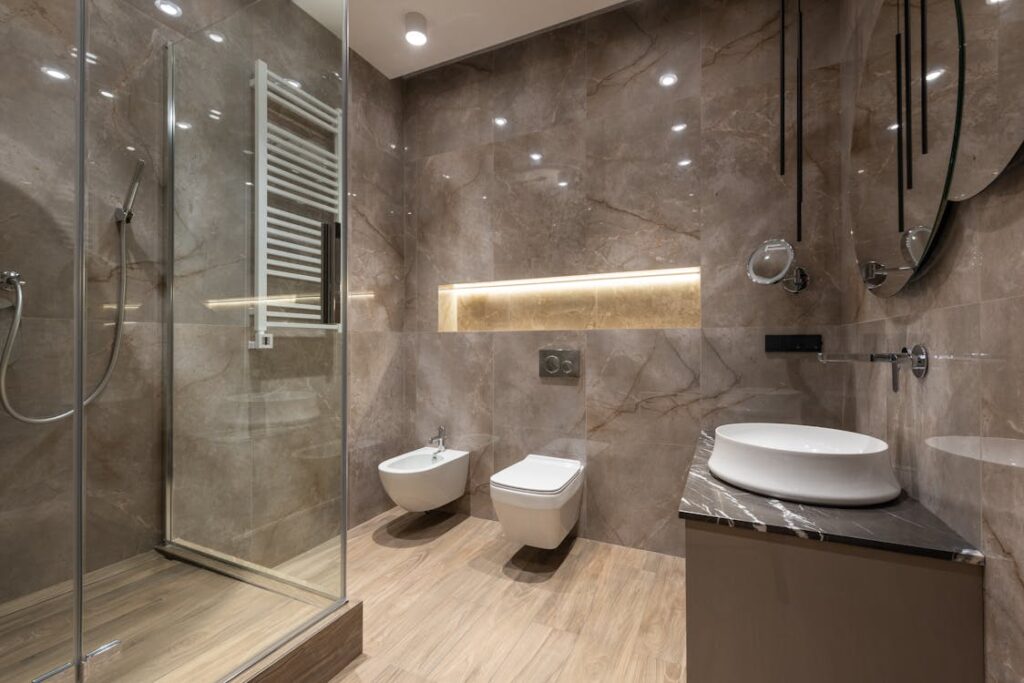
When selecting bathroom tiles, several key factors should influence your decision to ensure they meet your practical and design needs, similar to the careful planning involved in modular kitchen interior design in Bangalore or living area interior design in Bangalore.
Moisture Resistance
Given that bathrooms are constantly exposed to moisture, choosing tiles that can withstand water exposure is crucial. Porcelain and ceramic tiles are highly recommended for their water-resistant properties. Natural stones like marble or travertine can also be used, but they need to be sealed regularly to avoid water absorption and staining.
Slip Resistance
Bathroom floors can become slippery, especially when wet, so opting for tiles with slip-resistant features is essential. Look for tiles that have a textured surface or a matte finish to reduce the risk of slipping. When in doubt, porcelain tiles with an R10 or R11 slip-resistant rating are a safe bet for floors.
Durability
Tiles need to be durable enough to withstand heavy foot traffic, cleaning products, and high moisture levels. Porcelain tiles are ideal for durability, especially for floors. However, natural stone tiles like granite and marble are more susceptible to scratching and staining and require additional care.
Maintenance
Different tiles require different levels of maintenance. Ceramic and porcelain tiles are the easiest to maintain, requiring only periodic cleaning with mild soap and water. On the other hand, natural stone tiles may need sealing to protect them from stains and water damage.
4. Tile Size and Layout Considerations
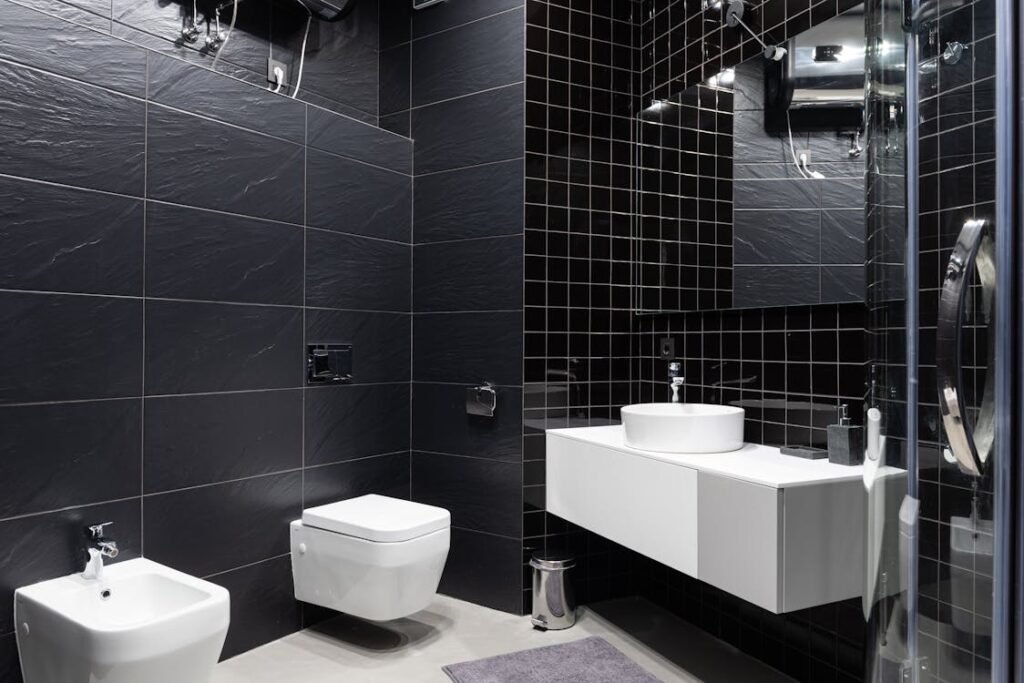
The size and layout of your tiles can significantly impact the overall feel of the bathroom. A well-thought-out design will make the space appear more expansive and harmonious, just like an expertly crafted living area interior design in Bangalore.
Tile Size and Space Perception
- Large Tiles: Large-format tiles have fewer grout lines, which can make a small bathroom feel more spacious and open. They are ideal for walls or larger bathroom floors.
- Small Tiles: Smaller tiles, such as mosaics, are perfect for adding visual interest and can be used for accent walls or around sinks. However, they can make small spaces feel busier if not used carefully.
Tile Layout and Patterns
- Subway Tiles: This classic layout, where rectangular tiles are stacked in a brick pattern, offers a timeless, clean look.
- Herringbone Pattern: A sophisticated pattern that adds texture and depth to the bathroom.
- Grid or Straight Lay: A simple, modern layout that is ideal for minimalist bathroom designs.
- Diagonal Layout: This layout creates a dynamic feel and can make a room feel larger.
5. Color and Style Choices
Your tile color should complement the rest of your bathroom’s design, much like the harmonious balance found in a modular kitchen interior design in Bangalore. Color choices affect the ambiance, so it’s important to pick tiles that align with the overall mood you want to create.
Neutral vs. Bold Colors
- Neutral Colors: White, gray, beige, and soft pastels are timeless choices that create a calm, serene environment.
- Bold Colors: Dark tones like navy, black, or emerald green make a statement and can modernize the bathroom. These can work well for accent walls or smaller areas.
Matching Tiles to Bathroom Style
- Modern Bathrooms: Clean lines with large tiles in neutral tones work well for a sleek, minimalist look.
- Traditional Bathrooms: Natural stone, classic subway tiles, and intricate mosaics give a bathroom a warm, classic feel.
- Coastal Style: Soft blues, whites, and light, textured tiles can create a refreshing, beachy vibe.
Creating Contrast and Visual Interest
Mixing finishes or incorporating accent tiles in bold colors or patterns can help break up a monochromatic look and add layers of depth to your bathroom’s design.
6. Practical Tips for Picking Bathroom Tiles
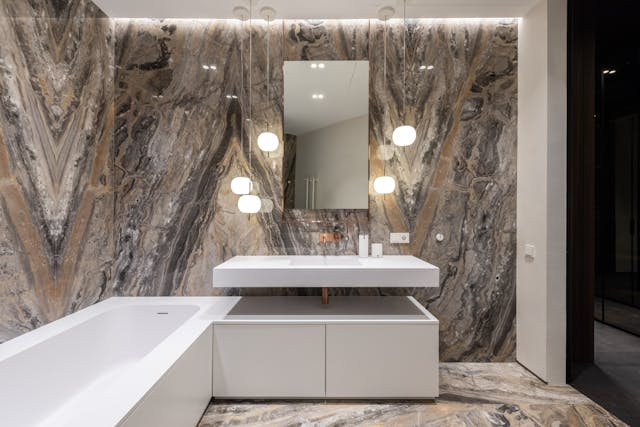
Test Tile Samples Before Committing
It’s always a good idea to take home tile samples and see how they look in your bathroom. Lighting can change the way tiles appear, so testing them in different conditions will help you make the right choice.
Factor in Bathroom Size and Lighting
- Small Bathrooms: Lighter tiles can make a small bathroom feel larger and more open.
- Larger Bathrooms: Darker tones or more intricate patterns can add warmth and interest.
Consider Long-Term Trends
While trendy tiles can be fun, they may not have long-term appeal. Opt for timeless designs like subway tiles or neutral tones that will always remain in style.
Tile Maintenance and Care
Ensure proper sealing of grout lines to avoid mildew buildup, and clean tiles regularly to keep them in good shape. Consider porcelain or ceramic tiles for easier maintenance.
7. Budget Considerations
Tile costs can vary greatly depending on the material and design. Porcelain and ceramic tiles are relatively affordable, while natural stone tiles like granite or marble can be pricier. Set a realistic budget, and remember that you can splurge on accent tiles or statement walls while keeping the floor tiles more cost-effective.
DIY vs. Professional Installation
If you’re handy with DIY projects, you might consider installing your tiles yourself. However, for more complex designs or areas like showers, hiring a professional ensures precision and avoids costly mistakes.
8. Working with a Bathroom Designer or Contractor
If you’re unsure about your tile choices or the overall bathroom design, working with a professional designer can make the process easier. Just as with modular kitchen interior design in Bangalore.
living area interior design in Bangalore, a designer can help you select the best tiles for your space while ensuring that the design flows seamlessly with the rest of your home.
Conclusion
Choosing the right bathroom tiles is an essential step in creating a space that is both beautiful and functional. By considering the key factors—moisture resistance, durability, slip resistance, and style—you can select tiles that will elevate your bathroom’s design and stand the test of time. Just like with modular kitchen interior design in Bangalore or living area interior design in Bangalore, thoughtful selection and planning will ensure that your bathroom becomes a harmonious part of your home.

